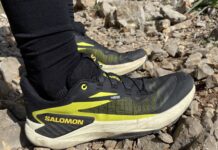
From my very first run in the Brooks Mazamas, I knew there was something special on my feet. The fit, the comfort, the speed, the stability.
Everything about this shoe suggests that trail runners will find their times decreasing and their chances for a PR increasing.
Brooks Mazama General Info
Soon after trying out the Mazamas (9.3 ounces, 6 mm drop), I knew that I would wear them during my second ultra marathon, exactly 10 weeks after my first 50K.
While there were other differences between the two races, thanks to my Mazamas, I shattered my first 50K time by over 75 minutes and placed in about the top 10 percent of all runners.
The Mazamas construction enabled me to enjoy a quicker pace without worrying about conditions of the trail.
The Mazamas guided me through rocky ascents and descents, guided me through sections of sandy trail and allowed me to cruise through the flat sections of the trails and prairie.
Brooks Mazama Sole Unit
Let’s focus on the midsole. Brooks has added a propulsion plate to the Mazama, below the forefoot midsole foam.
More than anything else, this plate provides the stability to traverse obstacles while the shoe’s light feel allows the runner to zoom through the trails.
I felt quite comfortable pushing off, whether I was running through single-track, a grassy cross-country course, a rocky climb or any other terrain.
And when it came to the rocky sections of trail, the propulsion plate protected my feet from any jaggedy or hard rocks.
When it comes to the outsole, the two-directional lug pattern is useful when maneuvering up or down hills, as well as through sand, mud and regular dirt trails.
(I am curious how they will perform in winter, through ice and snow. But if I had to guess, the Mazamas will be able to handle those conditions as well.)
I did find the toebox to be quite roomy, not Altra-sized roomy but enough so that my toes could splay out — which was important during the ultra race.
This part of the design is probably what likens these shoes to road shoes more than anything else. The comfort, sleek fit and roomy toebox all certainly work together for the fast ride.
At the other end of the shoe, the heel cup may strike some runners as too minimally padded. For my purposes the heel padding provided enough protection in the rocky sections of trail.
But I could see how a runner venturing out on a much more technical trail would want additional protection.
Brooks Mazama Upper Info
The upper part of the shoe is highlighted by a double mesh system that hugs the foot while not overheating it.
Many of the Mazama miles I did prior to this review were when the temperature was in the 80s or 90s, and my feet never experienced overheating, blisters or any other related issues.
The laces might seem thin to some runners, but for me, they worked well. I have a tendency to tie my laces too tight but I was never tempted to do so with these thinner laces.
The tongue caught me by surprise. It is comfortable and works well for the purposes I needed. It’s as minimalistic as they come with basically no padding.
For those running on extremely rocky or dirty terrain, they might want to add gaiters or look at a shoe with more protection.
Brooks Mazama Conclusions
I have tried various types of trail shoes but none have the quickness I experienced with the Mazamas. Some others were built to traverse rocky, muddy or other extreme technical terrain.
The one and only downfall I found with the Mazamas is that they won’t perform quite as well in deep mud or very rocky terrain — the extremes of trail running.
In all other cases, I would recommend what I will be wearing going forward on my feet at my ultras and other trail races — the Brooks Mazamas.
We thank the nice people at Brooks for sending us a pair of Mazama to test. This did not influence the outcome of the review, written after running more than 50 miles in them.





























